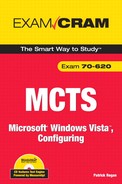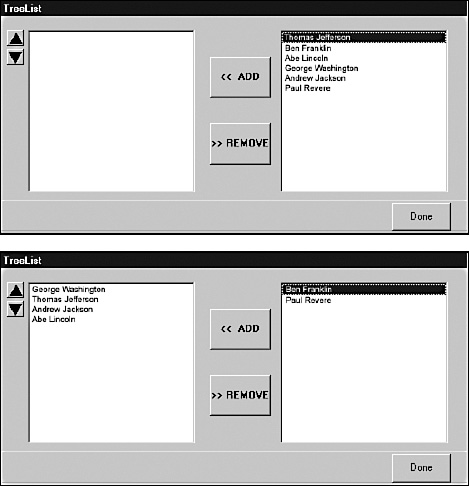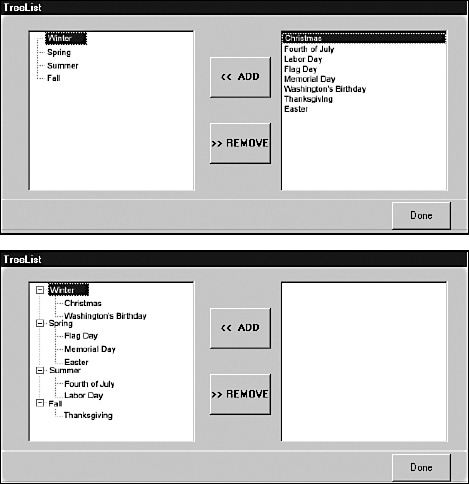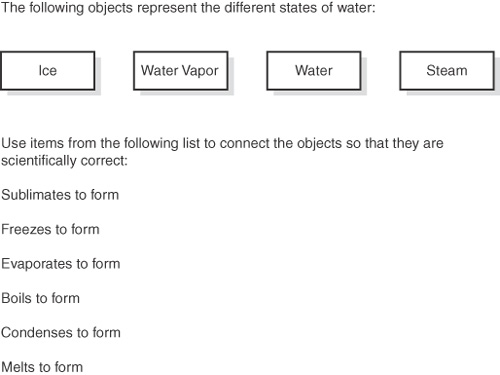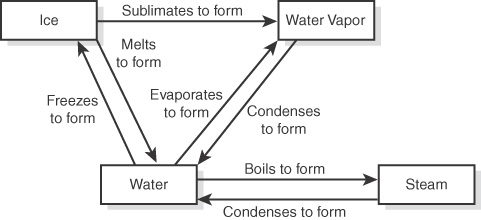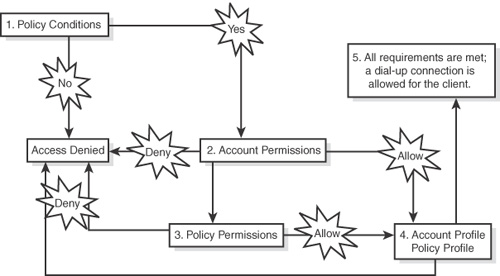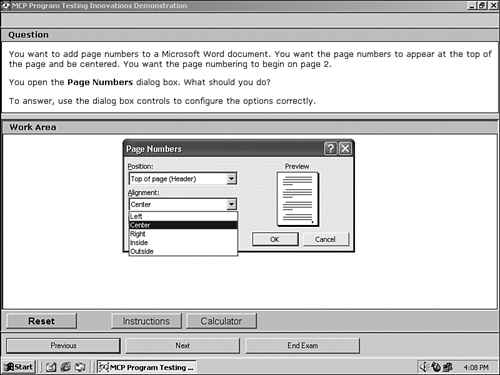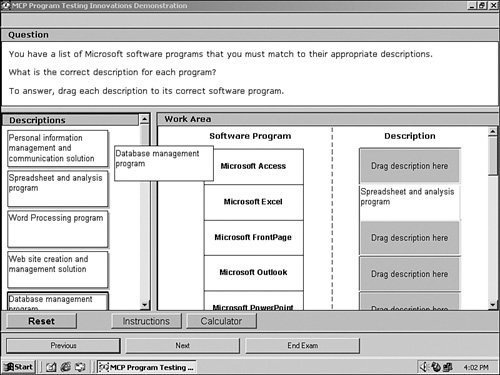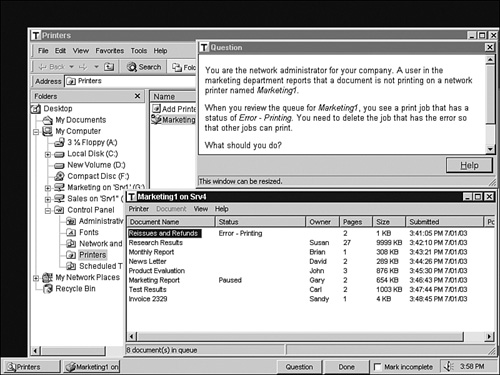This section explains different types of questions you might see on the exam. You learn strategies for handling questions and techniques for preparing for the exam.
Historically, there have been six types of question formats on Microsoft certification exams. These types of questions continue to appear on current Microsoft tests, and they are discussed in the following sections:
Some exam questions require you to select a single answer, whereas others ask you to select multiple correct answers. The following multiple-choice question requires you to select a single correct answer. Following the question is a brief summary of each potential answer and why it is either right or wrong.
This sample question format corresponds closely to the Microsoft certification exam format. The only difference is that on the exam, the questions are not followed by answers and their explanations. To select an answer, you position the cursor over the option button next to the answer you want to select. Then, you click the mouse button to select the answer.
Let’s examine a question for which one or more answers are possible. This type of question provides check boxes rather than option buttons for marking all appropriate selections.
What can you use to seize FSMO roles? (Choose two.)
| |||||||||
Answers A and B are correct. You can seize roles from a server that is still running through the Active Directory Users and Computers console, or in the case of a server failure, you can seize roles with the |
This particular question requires two answers. Microsoft sometimes gives partial credit for partially correct answers. For Question 2, you have to mark the check boxes next to answers A and B to obtain credit for a correct answer. Notice that choosing the right answers also means knowing why the other answers are wrong.
Questions in the build-list-and-reorder format present two lists of items—one on the left and one on the right. To answer the question, you must move items from the list on the right to the list on the left. The final list must then be reordered into a specific sequence.
These questions generally sound like this: “From the following list of choices, pick the choices that answer the question. Arrange the list in a certain order.” Question 3 shows an example of how they appear in this book; for an example of how they appear on the test, see Figure I.1.
From the following list of famous people, choose those who have been elected president of the United States. Arrange the list in the order in which the presidents served.
| |
The correct answer is
|
On an actual exam, the entire list of famous people would initially appear in the list on the right. You would move the four correct answers to the list on the left and then reorder the list on the left. Notice that the answer to Question 3 does not include all the items from the initial list. However, that might not always be the case.
To move an item from the right list to the left list on the exam, you first select the item by clicking it, and then you click the Add button (left arrow). After you move an item from one list to the other, you can move the item back by first selecting the item and then clicking the appropriate button (either the Add button or the Remove button). After you move items to the left list, you can reorder an item by selecting the item and clicking the up or down arrow buttons.
Questions in the create-a-tree format also present two lists—one on the left side of the screen and one on the right side of the screen. The list on the right consists of individual items, and the list on the left consists of nodes in a tree. To answer the question, you must move items from the list on the right to the appropriate node in the tree.
These questions can best be characterized as simply a matching exercise. Items from the list on the right are placed under the appropriate category in the list on the left. Question 4 shows an example of how they appear in this book; for an example of how they appear on the test, see Figure I.2.
The calendar year is divided into four seasons:
Identify the season during which each of the following holidays occurs:
| |
The correct answers are
|
In this case, you use all the items in the list. However, that might not always be the case.
To move an item from the right list to its appropriate location in the tree, you must first select the appropriate tree node by clicking it. Then, you select the item to be moved and click the Add button. Once you add one or more items to a tree node, the node appears with a + icon to the left of the node name. You can click this icon to expand the node and view the items you have added. If you have added any item to the wrong tree node, you can remove it by selecting it and clicking the Remove button.
Questions in the drag-and-connect format present a group of objects and a list of “connections.” To answer the question, you must move the appropriate connections between the objects.
This type of question is best described using graphics. Question 5 shows an example.
Questions in the select-and-place (drag-and-drop) format display a diagram with blank boxes and a list of labels that you need to drag to correctly fill in the blank boxes. To answer such a question, you must move the labels to their appropriate positions on the diagram.
This type of question is best described using graphics. Question 6 shows an example.
Starting with the exams released for the Windows Server 2003 MCSE track, Microsoft introduced several new question types in addition to the more traditional types of questions that are still widely used on all Microsoft exams. These innovative question types have been highly researched and tested by Microsoft before they were chosen to be included in many of the “refreshed” exams for the MCSA/MCSE on the Windows 2000 track and for the new MCSA/MCSE exams on the Windows Server 2003 track. These special question types are as follows:
Hot area questions
Active screen questions
Drag-and-drop–type questions
Simulation questions
Hot area questions ask you to indicate the correct answer by selecting one or more elements within a graphic. For example, you might be asked to select multiple objects within a list, as shown in Figure I.7.
Active screen questions ask you to configure a dialog box by modifying one or more elements. These types of questions offer a realistic interface in which you must properly configure various settings, just as you would within the actual software product. For example, you might be asked to select the proper option within a drop-down list box, as shown in Figure I.8.
New drag-and-drop questions ask you to drag source elements to their appropriate corresponding targets within a work area. These types of questions test your knowledge of specific concepts and their definitions or descriptions. For example, you might be asked to match a description of a computer program to the actual software application, as shown in Figure I.9
Simulation questions ask you to indicate the correct answer by performing specific tasks, such as configuring and installing network adapters or drivers, configuring and controlling access to files, or troubleshooting hardware devices. Many of the tasks that systems administrators and systems engineers perform can be presented more accurately in simulations than in most traditional exam question types (see Figure I.10).
Currently, Microsoft uses three different testing formats:
Fixed length
Short form
Case study
Other Microsoft exams employ advanced testing capabilities that might not be immediately apparent. Although the questions that appear are primarily multiple-choice, the logic that drives them is more complex than that in older Microsoft tests, which use a fixed sequence of questions, called a fixed-length test. Some questions employ a sophisticated user interface, which Microsoft calls a simulation, to test your knowledge of the software and systems under consideration in a more-or-less “live” environment that behaves just like the real thing. You should review the Microsoft Learning, Reference, and Certification Web pages at http://www.microsoft.com/learning/default.mspx for more detailed information.
In the future, Microsoft might choose to create exams using a well-known technique called adaptive testing to establish a test taker’s level of knowledge and product competence. In general, adaptive exams might look the same as fixed-length exams, but they discover the level of difficulty at which an individual test taker can correctly answer questions. Test takers with differing levels of knowledge or ability therefore see different sets of questions; individuals with high levels of knowledge or ability are presented with a smaller set of more difficult questions, whereas individuals with lower levels of knowledge are presented with a larger set of easier questions. Two individuals might answer the same percentage of questions correctly, but the test taker with a higher knowledge or ability level will score higher because his or her questions are worth more. Also, the lower-level test taker will probably answer more questions than his or her more-knowledgeable colleague. This explains why adaptive tests use ranges of values to define the number of questions and the amount of time it takes to complete the test.
Most adaptive tests work by evaluating the test taker’s most recent answer. A correct answer leads to a more difficult question, and the test software’s estimate of the test taker’s knowledge and ability level is raised. An incorrect answer leads to a less difficult question, and the test software’s estimate of the test taker’s knowledge and ability level is lowered. This process continues until the test targets the test taker’s true ability level. The exam ends when the test taker’s level of accuracy meets a statistically acceptable value (in other words, when his or her performance demonstrates an acceptable level of knowledge and ability) or when the maximum number of items has been presented (in which case, the test taker is almost certain to fail).
Microsoft has also introduced a short-form test for its most popular tests. This test delivers 25 to 30 questions to its takers, giving them exactly 60 minutes to complete the exam. This type of exam is similar to a fixed-length test in that it allows readers to jump ahead or return to earlier questions and to cycle through the questions until the test is done. Microsoft does not use adaptive logic in short-form tests, but it claims that statistical analysis of the question pool is such that the 25 to 30 questions delivered during a short-form exam conclusively measure a test taker’s knowledge of the subject matter in much the same way as an adaptive test. You can think of the short-form test as a kind of “greatest hits exam” (that is, it covers the most important questions) version of an adaptive exam on the same topic.
Because you won’t know which form the Microsoft exam might take, you should be prepared for either a fixed-length or short-form exam. The layout is the same for both fixed-length and short-form tests—you are not penalized for guessing the correct answer(s) to questions, no matter how many questions you answer incorrectly.
One tactic that has worked well for many test takers is to answer each question as well as you can before time expires on the exam. Some questions you will undoubtedly feel better equipped to answer correctly than others; however, you should still select an answer to each question as you proceed through the exam. You should click the Mark for Review check box for any question that you are unsure of. In this way, at least you have answered all the questions in case you run out of time. Unanswered questions are automatically scored as incorrect; answers that are guessed at have at least some chance of being scored as correct. If time permits, once you answer all questions, you can revisit each question that you have marked for review. This strategy also allows you to possibly gain some insight to questions that you are unsure of by picking up some clues from the other questions on the exam.
Tip
Some people prefer to read over the exam completely before answering the trickier questions; sometimes, information supplied in later questions sheds more light on earlier questions. At other times, information you read in later questions might jog your memory about facts, figures, or behavior that help you answer earlier questions. Either way, you could come out ahead if you answer only those questions on the first pass that you’re absolutely confident about. However, be careful not to run out of time if you choose this strategy!
Fortunately, the Microsoft exam software for fixed-length and short-form tests makes the multiple-visit approach easy to implement. At the top-left corner of each question is a check box that permits you to mark that question for a later visit.
Here are some question-handling strategies that apply to fixed-length and short-form tests. Use them if you have the chance:
When returning to a question after your initial read-through, read every word again; otherwise, your mind can miss important details. Sometimes, revisiting a question after turning your attention elsewhere lets you see something you missed, but the strong tendency is to see what you’ve seen before. Avoid that tendency at all costs.
If you return to a question more than twice, articulate to yourself what you don’t understand about the question, why answers don’t appear to make sense, or what appears to be missing. If you chew on the subject awhile, your subconscious might provide the missing details, or you might notice a “trick” that points to the right answer.
As you work your way through the exam, another counter that Microsoft provides will come in handy—the number of questions completed and questions outstanding. For fixed-length and short-form tests, it’s wise to budget your time by making sure that you’ve completed one-quarter of the questions one-quarter of the way through the exam period and three-quarters of the questions three-quarters of the way through.
If you’re not finished when only five minutes remain, use that time to guess your way through any remaining questions. Remember, guessing is potentially more valuable than not answering. Blank answers are always wrong, but a guess might turn out to be right. If you don’t have a clue about any of the remaining questions, pick answers at random or choose all As, Bs, and so on. (Choosing the same answer for a series of question all but guarantees you’ll get most of them wrong, but it also means you’re more likely to get a small percentage of them correct.)
For those questions that have only one right answer, usually two or three of the answers will be obviously incorrect and two of the answers will be plausible. Unless the answer leaps out at you (if it does, reread the question to look for a trick; sometimes those are the ones you’re most likely to get wrong), begin the process of answering by eliminating those answers that are most obviously wrong.
You can usually immediately eliminate at least one answer out of the possible choices for a question because it matches one of these conditions:
The answer does not apply to the situation.
The answer describes a nonexistent issue, an invalid option, or an imaginary state.
After you eliminate all answers that are obviously wrong, you can apply your retained knowledge to eliminate further answers. You should look for items that sound correct but refer to actions, commands, or features that are not present or not available in the situation that the question describes.
If you’re still faced with a blind guess among two or more potentially correct answers, reread the question. Picture how each of the possible remaining answers would alter the situation. Be especially sensitive to terminology; sometimes the choice of words (“remove” instead of “disable”) can make the difference between a right answer and a wrong one.
You should guess at an answer only after you’ve exhausted your ability to eliminate answers and you are still unclear about which of the remaining possibilities is correct. An unanswered question offers you no points, but guessing gives you at least some chance of getting a question right; just don’t be too hasty when making a blind guess.
Numerous questions assume that the default behavior of a particular utility is in effect. If you know the defaults and understand what they mean, this knowledge will help you cut through many of the trickier questions. Simple “final” actions might be critical as well. If you must restart a utility before proposed changes take effect, a correct answer might require this step as well.
In the final analysis, knowledge breeds confidence, and confidence breeds success. If you study the materials in this book carefully and review all the practice questions at the end of each chapter, you should become aware of the areas where you need additional learning and study.
After you’ve worked your way through the book, take the practice exams in the back of the book. Taking these tests provides a reality check and helps you identify areas to study further. Make sure you follow up and review materials related to the questions you miss on the practice exams before scheduling a real exam. Don’t schedule your exam appointment until after you’ve thoroughly studied the material and you feel comfortable with the whole scope of the practice exams. You should score 80% or better on the practice exams before proceeding to the real thing. (Otherwise, obtain some additional practice tests so that you can keep trying until you hit this magic number.)
Tip
If you take a practice exam and don’t get at least 70% to 80% of the questions correct, keep practicing. Microsoft provides links to practice-exam providers and also self-assessment exams at http://www.microsoft.com/learning/mcpexams/prepare/default.asp.
Armed with the information in this book and with the determination to augment your knowledge, you should be able to pass the certification exam. However, you need to work at it, or you’ll spend the exam fee more than once before you finally pass. If you prepare seriously, you should do well.
The next section covers other sources that you can use to prepare for Microsoft certification exams.
A good source of information about Microsoft certification exams comes from Microsoft itself. Because its products and technologies—and the exams that go with them—change frequently, the best place to go for exam-related information is online.
Microsoft offers training, certification, and other learning-related information and links at the http://www.microsoft.com/learning web address. If you haven’t already visited the Microsoft Training and Certification website, you should do so right now. The Microsoft Training and Certification home page resides at http://www.microsoft.com/learning/default.mspx.
